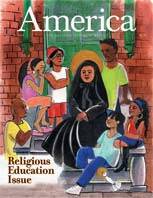As a new academic year begins, generalizations about American Catholic elementary and secondary education are risky, because there are signs both of losses and gains. Losses because with the closing of many financially strapped schools the system is smaller than it once was. Forty years ago, the population of the United States was about 193 million; some 45 million of these considered themselves Catholics. At that time, according to the OfficialCatholic Directory for 1965, there were 10,931 Catholic elementary schools (most of them parochial) enrolling more than 4.5 million children, and 2,465 secondary schools (diocesan, parochial and independent) with nearly 1.1 million students.
Today the U.S. population is close to 300 million, and 23 percent of this total, or approximately 68 million, are counted as Catholics. The Catholic school system, however, although still impressively sizable, has shrunk. The National Catholic Educational Association reports that in 2004-5 there were 7,799 American Catholic schools (6,574 elementary and 1,225 secondary) with a combined enrollment of 2,420,590.
Rising costs have been the main cause of this shrinkage. Ninety percent of the teachers in Catholic schools in 1950 were sisters, brothers or priests. Moreover, many elementary schools charged no tuition fees; the parishes supported the schools. Last year, 95 percent of the teachers were laypersons. The salary scales in these Catholic schools do not match those of public schools in wealthy suburbs, but it is still a scramble to meet the payroll.
All the same, generalizations must be made with care, because the landscape has bright areas as well as dark. To begin with, Catholic schools have more prestige today than they did in the 1930’s. Catholic elementary schools in the inner cities are often judged superior to the neighborhood public schools and are popular with low-income minority families, whether Catholic or not.
There are also some new seeds sproutingsmall innovative urban schools serving particularly those low-income groups.
In 1971, a small middle school (grades 6 to 8) was opened at the Nativity Mission Center in lower Manhattan. Since then it has served as a model for similar schools elsewhere. Last year there were 41 of these schools, with a total enrollment of 2,500. This September, the Nativity Educational Centers Network will include 45 schools in 28 cities from coast to coast. Some are single-sex; some are coed. All provide lower-income children with an education that will help them win admittance to a superior high school.
The Cristo Rey Network is even more recent. It is a national association of 11 high schools, six of them founded last year, that replicate a program developed for Latino students at the Cristo Rey Jesuit High School in Chicago in 1996. More than 14 religious orders and congregations are sponsoring these schools, and a central office shares information and monitors allegiance to the schools’ basic inspiration. These schools combine a solid college preparatory curriculum with a corporate internship program that makes it possible for students to pay for part of their schooling by working one day a week in local business offices that are enthusiastic cooperators.
In the Diocese of Memphis, there has been a development that is more like a rebirth than a fresh sowing. In the 1990’s, Memphis was obliged to close a number of schools in impoverished African-American neighborhoods. Since 1999, under the leadership of Bishop J. Terry Steib, S.V.D., and Mary C. McDonald, the diocesan superintendent of education, seven of these schools have been reopened and are flourishing. Last year, these seven enrolled 800 students. A few months ago, a segment on the weekly Public Broadcasting System program Religion and Ethics Newsweekly provided a heartening glimpse of these children tapping happily away on computers in their up-to-the-minute facilities.
This renaissance was made possible by an anonymous gift, described in a local news story as in the multimillions. There may be hope here for traditional diocesan school systems. In many dioceses bishops are making heroic efforts to raise the dollars needed to keep going the schools they have. Might a general dedication to more aggressive fund-raising make it possible to reopen some of those schools closed by fiscal pressures? When Pierre Teilhard de Chardin, the Jesuit paleontologist and religious thinker, saw the cyclotron at Berkeley, he remarked that money is now the lifeblood of humanity. Or as the comedian Phil Silvers put it in a down-to-earth generalization: Money is not the question. It’s the answer.









But most important, and indeed the real reason we send our child to our local Catholic school, is the spiritual connections nurtured in our schools, as the article pointed out, that showed “the strongest effects of Catholic education.” They found that those who received Catholic education are more likely to say that “they pray regularly,” that “they would never leave the Catholic Church,” that they are highly committed to the mission of the church, that they have “a stronger attachment to the church” and that their relationship to the church is “quite important” to their lives.
It is for these reasons that our family continues to believe in, and will work for, the success of our local Catholic schools. It seems clear that the answer to the question “Does Catholic education make a difference?” is a resounding yes.